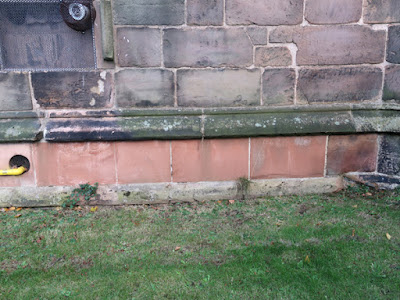 |
| A severely weathered grotesque at All Saints church |
The Church of All Saints in Aston is linked to the grounds of Aston Hall by an entrance with very large gate piers, which have elaborate vermiculated rustication that is very unusual in Rotherham. These have been built in a variety of Rotherham Red sandstone that is very dark in colour, which has been poorly repaired with sand and cement.
I visited All Saints church very briefly many years ago, but had a better look in 2016 after I had started my investigation of mediaeval churches in Rotherham and then during the Heritage Open Days festival, when I had a good look at its interior and went onto the roof of the tower. On this occasion, although I took a few photos of the weathered Permian dolomitic limestone headstops and grotesques, I was more interested in finding the Hill family grave in the churchyard.
The Grade II Listed gravestone (c1729) is in the form of a full-size coffin with a coped lid and with dropped handles carved in relief at each end. The Historic England listing records an inscription to John Hill that reads “'My Glass is Run My time / is spent no earthly care / can Death prevent” and describes it as being a most unusual gravestone of the period.
When leaving the churchyard, I stopped briefly to have a look at the stone repairs to the base of the tower. Although I don’t know which particular stone has been used, it is one of several Triassic sandstones that are produced in the UK – probably St. Bees sandstone, which is less bright than most and has been used recently for the restoration of the hood mould above the entrance to the Grade I Listed Chapel of Our Lady on the Bridge in Rotherham.
The Rotherham Red sandstone at All Saints church is quite variable in colour, with that immediately above the repairs being a plum/mauve variety although, as seen in the upper levels of the tower, the sandstone does have brighter red and yellowish shades and this makes it difficult to obtain a good matching stone.
Continuing with my search for the next building to photograph for the British Listed Buildings website, I stopped at the former coach house and stable block (1826) to Aston Hall – built by Harry Verelst, who was a colonial administrator with the British East India Company and the governor of Bengal from 1767 to 1769.
Now converted into three private residences, I could only get a quick view of the building from the entrance but, from my photos, I can see that the stone is remarkably similar to that seen in the buildings of Brampton-en-le-Morthen and Morthen. The west wing adjoining Church Lane has stone that is dominated by plum coloured blocks, compared to salmon pink on the east wing, and its window dressings have been largely replaced in what looks like concrete.
On the opposite side of the road is the old coach house and stables to the old rectory, High Trees, where differences in the weathering properties of the masonry on the east elevation appear to show a junction between phases of building. Also, looking at the stone roof tiles, in places they appear quite red beneath the patina. The Rotherham Red sandstone does have flaggy beds and, as seen at St. Helen’s church in Treeton, has occasionally been used for paving and I am curious to know if has been used as a roofing material.
Walking down to the end of Church Lane, the boundary walls to the Aston Hall lodge and High Trees show just how variable the Rotherham Red sandstone is in Aston, which is something that I had never noticed before when passing through on the X54 bus.
As I have highlighted in previous posts, although the colours of the Rotherham Red sandstone can vary from deep red, through plum/mauve to yellow in colour, with mottled varieties in between, I have not yet seen any quarries or exposures where this variation occurs.
Although only of academic or perhaps archaeological value, if the provenance of the various building stones were being researched, this arouses my curiosity as a geologist – especially since I had also recently encountered very similar colour variation in the historic buildings around Wickersley and Thurcroft.











No comments:
Post a Comment